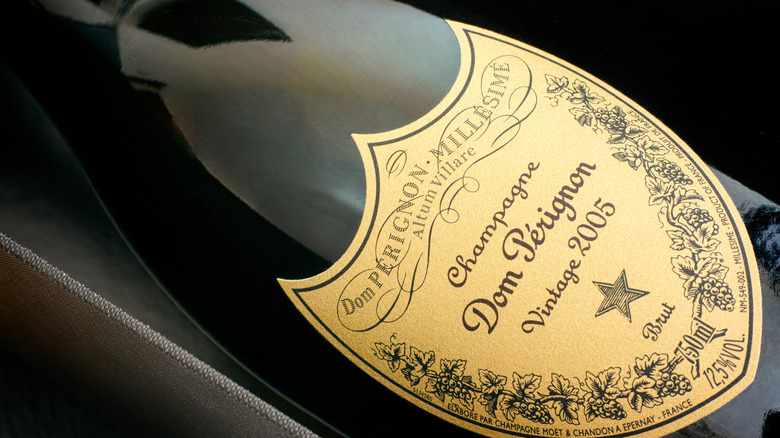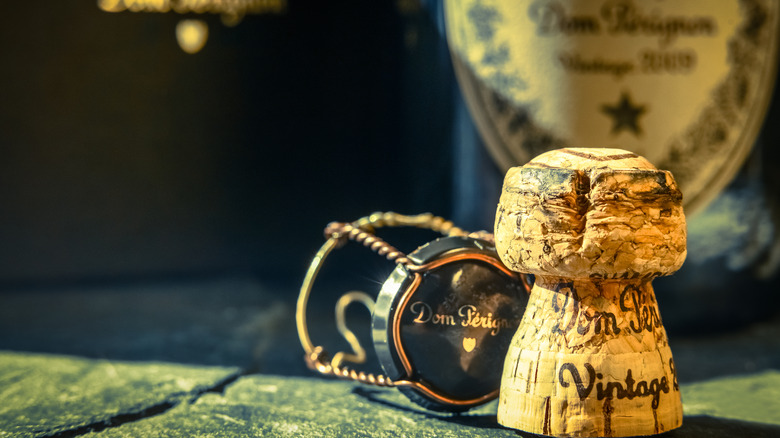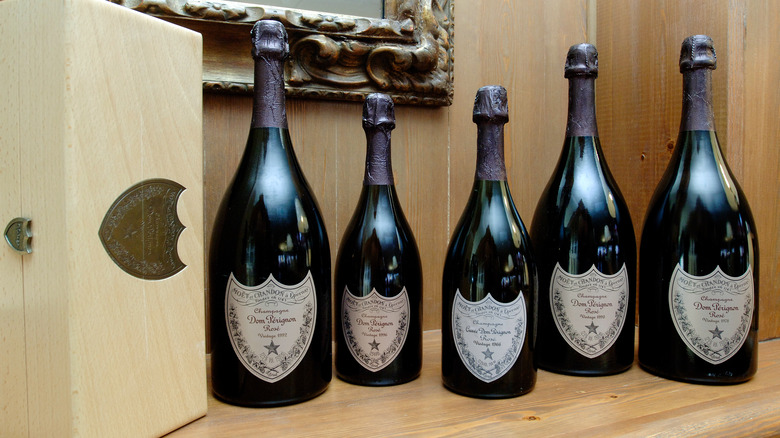Why Dom Pérignon Has Such A High Price Tag
When you think of luxury and opulence, the drink of choice is always Champagne. Whether it's poured to toast the new year or a new job, bubbly signifies celebration. Champagne and other sparkling wines come in a wide variety of styles and prices, but if you really want to toast a special occasion, nothing goes all out like a bottle of Dom Pérignon.
As one of the most internationally-recognized labels of Champagne, Dom Pérignon is a prestige cuvée from the house of Moët & Chandon that is a staple of the rich and famous. Equally at home with a few spoonfuls of caviar as it is next to a Lamborghini or Rolls Royce, no other sparkling wine is name-checked in popular culture like Dom as in TV shows like "Sex and the City," movies like "Die Hard," and songs by Billy Joel, 50 Cent, and even the Champagne Papi himself, Drake.
If you're out shopping for a fancy bottle of bubbly, the sticker shock on a bottle of this sparkling status symbol might be a bit of a surprise. Depending on the vintage, the cost of Dom can range from a starting price of around $150 all the way up into the many thousands of dollars for rarities, like a bottle meant for the wedding of Prince Charles and Lady Diana in 1981, per The New York Times. This is due to a mix of tradition, winemaking techniques, availability, and overall quality.
Vintage and aging
Two of the biggest factors in the price of Dom Pérignon are related to time. First, this Champagne is strictly vintage, which means that it is produced with grapes from a single growing year. This practice is common with many still wines, but not as common with high-end sparkling wines, and in fact, most Champagne houses only declare a vintage year three or four times a decade, according to Glass of Bubbly. The growing conditions and grapes have to be pretty special for a winemaker to declare a vintage year, and thus Dom Pérignon is not produced in what are considered weak years. This means that there are naturally fewer bottles of wine produced, increasing supply and demand.
Moët & Chandon also ages all their bottles of Dom Pérignon for at least eight years, according to Decanter, and the very best vintages can be aged 15, 20, and even 40 years before they are released for sale, which they denote by series called "Plenitudes." The most recent vintage is 2012, and you can look up the tasting notes for all of the 44 vintages since the first release in 1936 on the website. Just like aged whiskey, or any other alcohol that ages for a significant period of time before its sold, this age gap equals higher prices. According to The Oxford Social Club, this is because more work is put into creating the product.
Winemaking and reviews
In addition to scarcity and aging, Dom Pérignon Champagne is made with 50% Pinot Noir grapes and 50% Chardonnay grapes (per Decanter) and is produced with exacting winemaking techniques to maintain quality and consistency, and nearly always scores high marks with wine critics.
The wine's namesake, Dom Pierre Pérignon, was a Benedictine monk who pioneered many of the winemaking and grape-growing practices that are used to make Champagne today. The monk discovered more effective pruning measures that improved the concentration of the juice. He also incorporated methods of cultivating the grapes to do minimal damage that could affect the quality of the wine along with using "gentle pressings" to further avoid compromising the final product.
But how does the wine taste? According to Wine Spectator, since their critics started reviewing Dom Pérignon in 1985, the magazine's expert tasters have scored the wines at 90 points or higher on a 100-point scale 80% of the time, including 18 wines scoring 95 to 100 points, or what the magazine calls a "classic range." About as good as it gets!
In the United States, we drink more sparkling wines at the end of the year to toast the holidays, but sparkling wines are perfect for sipping and celebrating at any time. If you can afford a bottle of Dom, it's worth it for the ultimate indulgence. Just be sure to serve it in proper glassware so that you can taste all the nuances — no flutes, please!


